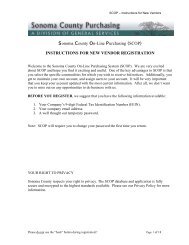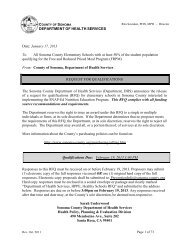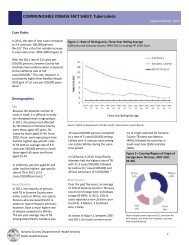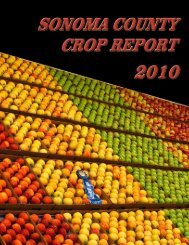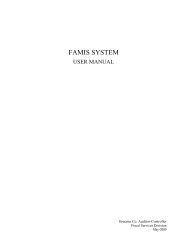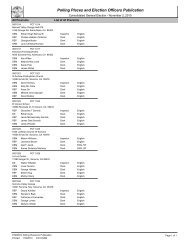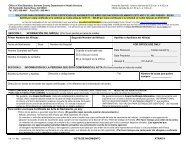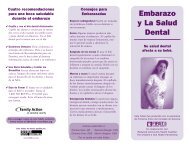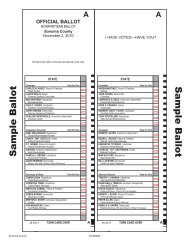Rancho Adobe Fire Protection District - Sonoma County
Rancho Adobe Fire Protection District - Sonoma County
Rancho Adobe Fire Protection District - Sonoma County
Create successful ePaper yourself
Turn your PDF publications into a flip-book with our unique Google optimized e-Paper software.
<strong>Rancho</strong> <strong>Adobe</strong> <strong>Fire</strong> <strong>Protection</strong> <strong>District</strong> <br />
Annual Report <br />
For the Fiscal Year Ended <br />
June 30, 2011 <br />
DONNA DUNK<br />
SONOMA COUNTY<br />
AUDITOR-CONTROLLER<br />
TREASURER-TAX COLLECTOR
<strong>Rancho</strong> <strong>Adobe</strong> <strong>Fire</strong> <strong>Protection</strong> <strong>District</strong> <br />
Basic Financial Statements <br />
For the Fiscal Year Ended <br />
June 30, 2011 <br />
Table of Contents<br />
Page<br />
Auditor’s Report<br />
Management’s Discussion and Analysis ..................................................................................... 1 – 5<br />
Basic Financial Statements: <br />
Government-wide Financial Statements: <br />
Statement of Net Assets ................................................................................................<br />
Statement of Activities ...................................................................................................<br />
Fund Financial Statements: <br />
Balance Sheet – General Fund .......................................................................................<br />
Statement of Revenues, Expenditures, and <br />
Changes in Fund Balance –General Fund ...................................................................<br />
Reconciliation of the Statement of Revenues, <br />
Expenditures and Changes in Fund Balance of <br />
General Fund to the Statement of Activities ................................................................<br />
Statement of Revenues, Expenditures and Changes in Fund<br />
Balance – Budget and Actual – General Fund ............................................................. 11 <br />
Notes to the Basic Financial Statements ................................................................................ 12 – 22<br />
Required Supplementary <br />
Information……………………………………………………………………….…...………… 23 -25 <br />
Roster of Board Members ...........................................................................................................… 26<br />
6 <br />
7<br />
8 <br />
9 <br />
10
Auditor-Controller <br />
Treasurer-Tax Collector<br />
<strong>County</strong> of <strong>Sonoma</strong><br />
DONNA DUNK<br />
PAM JOHNSTON<br />
INTERIM AUDITOR-CONTROLLER 585 FISCAL DRIVE ASSISTANT<br />
TREASURER -TAX COLLECTOR SUITE 100 TAX COLLECTOR/AUDITOR<br />
SANTA ROSA, CALIFORNIA<br />
95403-2819 JONATHAN KADLEC<br />
(707) 565-2631 ASSISTANT<br />
FAX (707) 565-3489<br />
TREASURER<br />
<br />
Board of Directors <br />
<strong>Rancho</strong> <strong>Adobe</strong> <strong>Fire</strong> <strong>Protection</strong> <strong>District</strong> <br />
<strong>Rancho</strong> <strong>Adobe</strong>, CA <br />
Auditor-Controller’s Report<br />
We have audited the accompanying financial statements of the <strong>Rancho</strong> <strong>Adobe</strong> <strong>Fire</strong> <strong>Protection</strong> <strong>District</strong> (the <strong>District</strong>),<br />
as of and for the year ended June 30, 2011, which collectively comprise the basic financial statements as listed in<br />
the table of contents. These basic financial statements are the responsibility of the <strong>District</strong>’s management. Our<br />
responsibility is to express an opinion on the financial statements based on our audit<br />
We conducted our audit in accordance with auditing standards generally accepted in the United States of America.<br />
Those standards require that we plan and perform the audit to obtain reasonable assurance about whether the<br />
financial statements are free of material misstatements. An audit includes examining, on a test basis, evidence<br />
supporting the amounts and disclosures in the financial statements. An audit also includes assessing the accounting<br />
principles used and significant estimates made by management, as well as evaluating the overall financial statement<br />
presentation. We believe that our audit provides a reasonable basis for our opinion.<br />
As required by various statutes within the California Government Code, <strong>County</strong> Auditor-Controller’s are mandated<br />
to perform certain accounting, auditing and financial reporting functions. These activities, in themselves,<br />
necessarily impair the auditor’s independence. Specifically, “Auditors should not audit their own work or provide<br />
non audit services in situations where the amounts or services involved are significant or material to the subject<br />
matter of the audit.” Although the office of the Auditor-Controller is statutorily obligated to maintain accounts of<br />
departments, districts or funds that are contained within the <strong>County</strong> Treasury, we believe that adequate safeguards<br />
and divisions of responsibility exist. The staff in charge of performing audits within the Auditor-Controller<br />
Department has no other responsibility for the accounts and records being audited. This would therefore enable the<br />
reader of this report to rely on the information contained herein.<br />
Management has not adopted a methodology for determining and disclosing the costs related to other postemployment<br />
benefits. Accounting principles generally accepted in the United States of America require disclosure<br />
of the value of non-pension post-employment benefits. The amount by which this departure would affect the<br />
financial statements is not reasonably determinable.<br />
In our opinion, except for the effects, if any, of the departure described in the preceding paragraph, the basic<br />
financial statements referred to above present fairly, in all material respects, the financial position of the <strong>District</strong> as<br />
of June 30, 2011, and the respective changes in its financial position for the year then ended, in conformity with<br />
accounting principles generally accepted in the United States of America.
The Management’s Discussion and Analysis (MD&A) on pages 1 through 5 is not a required part of the basic<br />
financial statements but are supplementary information required by the Government Accounting Standards Board.<br />
We have applied certain limited procedures, which consisted principally of inquiries of management regarding the<br />
methods of measurement and presentation of the required supplementary information. However, we did not audit<br />
the information and express no opinion on it.<br />
November 30, 2011
Management’s Discussion and Analysis<br />
As management of the <strong>Rancho</strong> <strong>Adobe</strong> <strong>Fire</strong> <strong>Protection</strong> <strong>District</strong> (the <strong>District</strong>) we offer readers of the<br />
<strong>District</strong>’s financial statements this narrative overview and analysis of the financial activities of the <strong>District</strong><br />
for the fiscal year ended June 30, 2011. We encourage readers to consider the information presented here<br />
in conjunction with the <strong>District</strong>’s financial statements and the accompanying notes to the financial<br />
statements.<br />
Financial Highlights<br />
1. The assets of the <strong>District</strong> exceeded its liabilities at the close of the most recent fiscal year by<br />
$2,660,924 (net assets). Of this amount, $1,150,083 (unrestricted net assets) may be used to meet<br />
the government’s ongoing obligations to citizens and creditors.<br />
2. The <strong>District</strong>’s total net assets decreased by $310,511. This decrease is a result of fire prevention<br />
expenses exceeding the <strong>District</strong>’s program and general revenues.<br />
3. As of the close of the current fiscal year, the <strong>District</strong>’s general fund reported an ending fund<br />
balance of $1,225,027 a decrease of $(284,130), in comparison with the prior year.<br />
Approximately 61% of this total amount is available for spending at the government’s discretion<br />
(unassigned fund balance).<br />
4. At the end of the year, unassigned fund balance for the general fund was $749,993 or 23% of the<br />
total general fund expenditure of $3,201,826.<br />
5. The <strong>District</strong>’s total long-term debt decreased by $201,717 or 30% during the current fiscal year<br />
due primarily to payments on long term debt and reduction in compensated absences.<br />
Overview of the Financial Statements<br />
This discussion and analysis is intended to serve as an introduction to the <strong>District</strong>’s basic financial<br />
statements. The <strong>District</strong>’s basic financial statements comprise three components: 1) government-wide<br />
financial statements, 2) fund financial statements, and 3) notes to the basic financial statements. This<br />
report also contains other supplementary information in addition to the basic financial statements<br />
themselves.<br />
Government-wide financial statements: The government-wide financial statements are designed to<br />
provide readers with a broad overview of the <strong>District</strong>’s finances, in a manner similar to a private-sector<br />
business.<br />
The statement of net assets presents information on all of the <strong>District</strong>’s assets and liabilities, with the<br />
difference between the two reported as net assets. Over time, increases or decreases in net assets may<br />
serve as a useful indicator of whether the financial position of the <strong>District</strong> is improving or deteriorating.<br />
The statement of activities presents information showing how the government’s net assets changed during<br />
the most recent fiscal year. All changes in net assets are reported as soon as the underlying event giving<br />
rise to the change occurs, regardless of the timing of related cash flows.<br />
Thus, revenues and expenses are reported in this statement for some items that will only result in cash<br />
flows in future fiscal periods (e.g., uncollected taxes and earned but unused vacation leave).<br />
Fund financial statements: A fund is a grouping of related accounts that is used to maintain control<br />
over resources that have been segregated for specific activities or objectives. The <strong>District</strong>, like other state<br />
1
and local governments, uses fund accounting to ensure and demonstrate compliance with finance-related<br />
legal requirements. The <strong>District</strong>’s funds are governmental funds.<br />
Governmental funds: Governmental funds are used to account for essentially the same functions<br />
reported as governmental activities in the government-wide financial statements. However, unlike the<br />
government-wide financial statements, governmental fund financial statements focus on near-term<br />
inflows and outflows of spendable resources, as well as on balances of spendable resources available at<br />
the end of the fiscal year. Such information may be useful in evaluating a government’s near-term<br />
financing requirements.<br />
Because the focus of governmental funds is narrower than that of the government-wide financial<br />
statements, it is useful to compare the information presented for governmental funds with similar<br />
information presented for governmental activities in the government-wide financial statements. By doing<br />
so, readers may better understand the long-term impact of the government’s near-term financing<br />
decisions. Both the governmental fund balance sheet and the governmental fund statements of revenues,<br />
expenditures, and changes in fund balances provide a reconciliation to facilitate this comparison between<br />
governmental funds and governmental activities.<br />
The <strong>District</strong> uses governmental funds to account for its activities, which include fire protection services in<br />
the district boundaries. The <strong>District</strong> uses and reports one fund. The district adopts an annual appropriated<br />
budget for its funds. A budgetary comparison statement has been provided for the general fund to<br />
demonstrate compliance with this budget.<br />
Notes to the financial statements: The notes provide additional information that is essential to a full<br />
understanding of the data provided in the government-wide and fund financial statements.<br />
Government-wide Financial Analysis<br />
As noted earlier, net assets may serve over time as a useful indicator of a government’s financial position.<br />
In the case of the <strong>District</strong>, assets exceeded liabilities by $2,660,924 at the close of the most recent fiscal<br />
year.<br />
A large portion of the <strong>District</strong>’s net assets, 57%, reflects its investment in capital assets (e.g., land,<br />
buildings and improvements and equipment). The <strong>District</strong> uses these capital assets to provide services to<br />
citizens; consequently, these assets are not available for future spending.<br />
2
Net Assets<br />
2011<br />
Current and other assets $ 1,514,400<br />
Capital assets 1,926,392<br />
Total assets 3,440,792<br />
Long-term liabilities outstanding 761,764<br />
Other liabilities outstanding 18,104<br />
Total liabilities 779,868<br />
Net assets:<br />
Invested in capital assets, net of related debt 1,510,841<br />
Unrestricted, as restated 1,150,083<br />
Total net assets $ 2,660,924<br />
The balance of unrestricted net assets $ 1,150,083 may be used to meet the <strong>District</strong>’s ongoing obligations<br />
to citizens and vendors.<br />
At the end of the current fiscal year, the <strong>District</strong> is able to report positive balances in both categories of<br />
net assets. The same held true for the prior fiscal year.<br />
Governmental activities: Governmental activities decreased the <strong>District</strong>’s net assets by $310,511. This<br />
decrease is a result of fire suppression expenses in excess of program general revenues.<br />
3
Change in Net Assets<br />
2011<br />
Revenues:<br />
Program Revenues:<br />
Public safety - fire protection $ 89,339<br />
General Revenues:<br />
Property taxes 2,797,088<br />
Investment income and other 27,017<br />
Total revenues 2,913,444<br />
Expenses:<br />
Program Expenses:<br />
Public safety - fire protection 3,222,248<br />
Total expenses 3,222,248<br />
Other financing sources (uses)<br />
Gain (Loss) on sale of capital asset (1,707)<br />
Increase (decrease) in net assets (310,511)<br />
Net assets - beginning of the year, as restated 2,971,435<br />
Net assets - end of the year $ 2,660,924<br />
Financial Analysis of the Government’s Funds<br />
As noted earlier, the <strong>District</strong> uses fund accounting to ensure and demonstrate compliance with financerelated<br />
requirements.<br />
Governmental funds: The focus of the <strong>District</strong>’s governmental fund is to provide information on nearterm<br />
inflows, outflows, and balances of spendable resources. Such information is useful in assessing the<br />
<strong>District</strong>’s financing requirements. In particular, unassigned fund balance may serve as a useful measure<br />
of a government’s net resources available for spending at the end of the fiscal year. The <strong>District</strong> uses and<br />
reports one fund, the general fund.<br />
The general fund is the chief operating fund of the <strong>District</strong>. As of the end of the current fiscal year, the<br />
<strong>District</strong>’s general fund reported ending fund balance of $1,225,027, a decrease of $(284,130) in<br />
comparison with the prior year. $749,993 of the total amount constitutes unassigned fund balance, which<br />
is available for spending at the government’s discretion. The remainder of fund balance is assigned for<br />
equipment and uncertainties.<br />
As a measure of the general fund’s liquidity, it may be useful to compare unassigned fund balance and<br />
total fund balance to total fund expenditures. Unassigned fund balance represents 23% of total general<br />
fund expenditures.<br />
4
General Fund Budgetary Highlights<br />
There were no material differences between the original budget and the final amended budget.<br />
Capital Asset and Debt Administration<br />
Capital assets. The <strong>District</strong>’s investment in capital assets, as of June 30, 2011, amounts to $1,926,392<br />
(net of accumulated depreciation). This investment in capital assets includes land, buildings and<br />
improvements, and equipment. The total decrease in the <strong>District</strong>’s investment in capital assets for the<br />
current fiscal year was $77,090, and is explained by the following events:<br />
Depreciation of the capital assets $104,000<br />
Purchase of equipment $32,869<br />
Retirement of capital assets $ (5,959)<br />
Additional information on the <strong>District</strong>’s capital assets can be found in note III.B of this report.<br />
Debt Administration: At the end of the current fiscal year, the <strong>District</strong> had total long-term obligations<br />
outstanding of $472,391 including $415,551 in a capital lease and $56,840 in compensated absences.<br />
During the current fiscal year, the <strong>District</strong>’s total long-term debt decreased by $201,717.<br />
Economic Factors and Next Year’s Budgets and Rates<br />
<br />
Continued decrease in property tax revenue. <br />
This factor was considered in preparing the <strong>District</strong>’s budget for the fiscal year ending June 30, 2012. <br />
Request for Information<br />
This financial report is designed to provide a general overview of the <strong>District</strong>’s finances for all those with<br />
an interest in the government’s finances. Questions concerning any of the information provided in this<br />
report or requests for additional financial information should be addressed to the <strong>District</strong>, P. O. Box 1029,<br />
Penngrove, CA 94951-1029.<br />
5
<strong>Rancho</strong> <strong>Adobe</strong> <strong>Fire</strong> <strong>Protection</strong> <strong>District</strong><br />
Statement of Net Assets<br />
For the Year Ended<br />
June 30, 2011<br />
Assets<br />
Cash and investments $ 1,494,557<br />
Accounts receivable 1,418<br />
Flat charges receivable 18,425<br />
Capital assets:<br />
Non-depreciable 74,634<br />
Depreciable, net 1,851,758<br />
Total assets 3,440,792<br />
Liabilities<br />
Accrued interest payable 18,104<br />
Capital lease - due within one year 56,396<br />
Non-current liabilities:<br />
Capital lease - Due in more than one year 359,155<br />
Compensated absences 56,840<br />
Deferred revenue 289,373<br />
Total liabilities 779,868<br />
Net Assets<br />
Invested in capital assets, net of related debt 1,510,841<br />
Unrestricted 1,150,083<br />
Total net assets $ 2,660,924<br />
The notes to the basic financial statements are an integral part of this statement.<br />
6
<strong>Rancho</strong> <strong>Adobe</strong> <strong>Fire</strong> <strong>Protection</strong> <strong>District</strong><br />
Statement of Activities<br />
For the Year Ended<br />
June 30, 2011<br />
Program Expenses<br />
Public safety - fire prevention<br />
Salaries and employee benefits<br />
Services and supplies<br />
Depreciation<br />
Interest on long-term debt<br />
Bad debt<br />
$ 2,525,497<br />
553,389<br />
104,000<br />
18,104<br />
21,258<br />
Total program expenses 3,222,248<br />
Program Revenues<br />
Charges for services<br />
Intergovernmental<br />
Other charges for services<br />
Total program revenues<br />
Net program revenues (expenses)<br />
23,082<br />
66,257<br />
89,339<br />
(3,132,909)<br />
General Revenues<br />
Property taxes<br />
Investment earnings<br />
Grants and donations<br />
Miscellaneous revenue<br />
Total general revenues<br />
2,797,088<br />
7,490<br />
7,010<br />
12,517<br />
2,824,105<br />
Other financing sources (uses)<br />
Loss on sale of capital asset<br />
(1,707)<br />
Change in net assets (310,511)<br />
Net assets - beginning of year<br />
Prior period adjustment<br />
Net assets - beginning of year, as restated<br />
Net assets - end of year $<br />
2,817,978<br />
153,457<br />
2,971,435<br />
2,660,924<br />
The notes to the basic financial statements are an integral part of this statement.<br />
7
Assets<br />
Cash and investments<br />
Cash with fiscal agent<br />
Accounts receivable<br />
Flat charges receivable<br />
<strong>Rancho</strong> <strong>Adobe</strong> <strong>Fire</strong> <strong>Protection</strong> <strong>District</strong><br />
Balance Sheet<br />
General Fund<br />
June 30, 2011<br />
$ 1,482,254<br />
12,303<br />
1,418<br />
18,425<br />
Total assets $ 1,514,400<br />
Liabilities and Fund Balance<br />
Liabilities:<br />
Deferred revenue $ 289,373<br />
Fund balance:<br />
Committed<br />
Assigned<br />
Unassigned<br />
Total fund balance<br />
Total liabilities 289,373<br />
56,840<br />
418,194<br />
749,993<br />
1,225,027<br />
Total liabilities and fund balance $ 1,514,400<br />
Reconciliation of Balance Sheet to Statement of Net Assets<br />
Fund balances - total governmental funds<br />
$ 1,225,027<br />
Amounts reported for governmental activities<br />
in the statement of net assets are different because:<br />
Capital assets used in governmental activities<br />
are not financial resources and therefore are<br />
not reported in the governmental funds 1,926,392<br />
Long-term liabilities are not due and payable<br />
in the current period and therefore are not<br />
reported in the governmental funds:<br />
Compensated absences<br />
Notes payable<br />
Accrued interest payable<br />
Net assets of governmental activities $<br />
(56,840)<br />
(415,551)<br />
(18,104)<br />
2,660,924<br />
The notes to the basic financial statements are an integral part of this statement.<br />
8
<strong>Rancho</strong> <strong>Adobe</strong> <strong>Fire</strong> <strong>Protection</strong> <strong>District</strong><br />
Statement of Revenues, Expenditures and<br />
Changes in Fund Balance<br />
General Fund<br />
For the Year Ended<br />
June 30, 2011<br />
Revenues<br />
Property taxes<br />
Investment earnings<br />
Intergovernmental revenue<br />
Charges for services<br />
Grants and donations<br />
Miscellaneous<br />
$ 2,797,088<br />
7,490<br />
23,082<br />
66,257<br />
7,010<br />
12,517<br />
Total revenues 2,913,444<br />
Expenditures<br />
Salaries and employee benefits<br />
Services and supplies<br />
Bad debt<br />
Capital outlay<br />
Debt Service:<br />
Principal<br />
Interest<br />
2,519,810<br />
553,389<br />
21,258<br />
32,869<br />
53,947<br />
20,553<br />
Total expenditures 3,201,826<br />
Excess (deficiency) of revenue over (under) expenditures (288,382)<br />
Other financing sources<br />
Sale of capital assets 4,252<br />
Net change in fund balances<br />
Fund balance - beginning of year<br />
(284,130)<br />
1,509,157<br />
Fund balance - end of year $ 1,225,027<br />
The notes to the basic financial statements are an integral part of this statement.<br />
9
<strong>Rancho</strong> <strong>Adobe</strong> <strong>Fire</strong> <strong>Protection</strong> <strong>District</strong><br />
Reconciliation of the Statement of Revenues, Expenditures and<br />
Changes in Fund Balance of General Fund<br />
to the Statement of Activities<br />
June 30, 2011<br />
Amounts reported for governmental activities in the<br />
statement of activities are different because:<br />
Net change in fund balances - total governmental funds $ (284,130)<br />
Governmental funds report capital outlays as expenditures. In the<br />
statement of activities the cost of those assets is allocated over<br />
their estimated useful lives and reported as depreciation expense.<br />
Expenditure for capital assets<br />
Disposal of capital assets<br />
Current year depreciation<br />
Repayment of note's principal is an expenditure in the governmental<br />
funds, but the repayment reduces long-term liabilities in the<br />
statement of net assets.<br />
Principal<br />
32,869<br />
(5,959)<br />
(104,000)<br />
53,947<br />
Change in compensated absences reported in the statement of<br />
activities does not require the use of current financial resources<br />
and, therefore is not reported as expenditures in governmental<br />
funds. (5,687)<br />
Some expenses reported in the statement of activities do not require the use<br />
of current resources and therefore are not reported as expenditures in<br />
governmental funds:<br />
Change in accrued interest 2,449<br />
Change in net assets of governmental activities $ (310,511)<br />
The notes to the basic financial statements are an integral part of this statement.<br />
10
Revenues<br />
Property taxes<br />
Investment earnings<br />
Intergovernmental revenue<br />
Charges for services<br />
Grants and donations<br />
Miscellaneous<br />
<strong>Rancho</strong> <strong>Adobe</strong> <strong>Fire</strong> <strong>Protection</strong> <strong>District</strong><br />
Statement of Revenues, Expenditures and Changes in Fund Balance -<br />
Budget and Actual - General Fund<br />
For the Fiscal Year Ended <br />
June 30, 2011<br />
Budgeted Amounts<br />
Original Final<br />
$ 2,829,304<br />
7,000<br />
220,000<br />
49,750<br />
-<br />
-<br />
$ 2,829,304<br />
7,000<br />
220,000<br />
49,750<br />
-<br />
-<br />
Actual<br />
Amounts<br />
$ 2,797,088<br />
7,490<br />
23,082<br />
66,257<br />
7,010<br />
12,517<br />
Variance with<br />
Final Budget -<br />
Positive<br />
(Negative)<br />
$ (32,216)<br />
490<br />
(196,918)<br />
16,507<br />
7,010<br />
12,517<br />
Total revenues 3,106,054 3,106,054 2,913,444 (192,610)<br />
Expenditures<br />
Current:<br />
Salaries and employee benefits<br />
Services and supplies<br />
Capital outlay<br />
Bad debt<br />
Other charges<br />
Debt Service:<br />
Principal<br />
Interest<br />
2,700,800<br />
357,508<br />
50,000<br />
-<br />
215,505<br />
53,948<br />
20,553<br />
2,700,800<br />
357,508<br />
50,000<br />
-<br />
215,505<br />
53,948<br />
20,553<br />
2,519,810<br />
553,389<br />
32,869<br />
21,258<br />
-<br />
53,947<br />
20,553<br />
180,990<br />
(195,881)<br />
17,131<br />
(21,258)<br />
215,505<br />
1<br />
-<br />
Total expenditures<br />
3,398,314<br />
3,398,314<br />
3,201,826<br />
196,488<br />
Excess (deficiency) of revenues<br />
over (under) expenditures<br />
(292,260)<br />
(292,260)<br />
(288,382)<br />
3,878<br />
Other financing sources<br />
Sale of capital assets<br />
Total other financing sources<br />
5,000<br />
5,000<br />
5,000<br />
5,000<br />
4,252<br />
4,252<br />
9,252<br />
9,252<br />
Net change in fund balances<br />
Fund balance - beginning of year<br />
(287,260)<br />
1,509,157<br />
(287,260)<br />
1,509,157<br />
(284,130)<br />
1,509,157<br />
13,130<br />
-<br />
Fund balance - end of year $ 1,221,897 $ 1,221,897 $ 1,225,027 $ 13,130<br />
The notes to the basic financial statements are an integral part of this statement.<br />
11
<strong>Rancho</strong> <strong>Adobe</strong> <strong>Fire</strong> <strong>Protection</strong> <strong>District</strong> <br />
Notes to the Basic Financial Statements <br />
June 30, 2011 <br />
I. Summary of Significant Accounting Policies<br />
A. Reporting Entity<br />
In December of 1993, <strong>Rancho</strong> <strong>Adobe</strong> <strong>Fire</strong> <strong>Protection</strong> <strong>District</strong> (the <strong>District</strong>), was formed when<br />
Penngrove <strong>Fire</strong> <strong>Protection</strong> <strong>District</strong> and Cotati <strong>Fire</strong> <strong>Protection</strong> <strong>District</strong> dissolved as individual<br />
districts to combine into <strong>Rancho</strong> <strong>Adobe</strong> <strong>Fire</strong> <strong>Protection</strong> <strong>District</strong>. The <strong>District</strong> was formed<br />
under Health and Safety Code Sections 13816 through 13822.<br />
B. Government-wide and Fund Financial Statements<br />
The government-wide financial statements (i.e., the statement of net assets and the statement<br />
of activities) report information on all of the non-fiduciary activities of the primary<br />
government. Governmental activities, which normally are supported by taxes and<br />
intergovernmental revenues, are reported separately.<br />
The statement of activities demonstrates the degree to which the direct expenses, of a given<br />
function or segment, are offset by program revenues. Direct expenses are those that are clearly<br />
identifiable with a specific function or segment. Program revenues include 1) charges to<br />
customers or applicants who purchase, use or directly benefit from goods, services, or<br />
privileges provided by a given function or section and 2) grants and contributions that are<br />
restricted to meeting operational or capital requirements of a particular function or segment.<br />
Taxes and other items not properly included among program revenues are reported instead as<br />
general revenues.<br />
Separate financial statements are provided for governmental funds. Major individual<br />
governmental funds are reported as separate columns in the fund financial statements.<br />
C. Measurement Focus, Basis of Accounting, and Financial Statement Presentation<br />
The government-wide financial statements are reported using the economic resources<br />
measurement focus and the accrual basis of accounting. Revenues are recorded when earned<br />
and expenses are recorded when a liability is incurred, regardless of the timing of the related<br />
cash flows. Property taxes are recognized as revenues in the year for which they are levied.<br />
Grants and similar items are recognized as revenue as soon as all eligibility requirements<br />
imposed by the provider have been met.<br />
Governmental fund financial statements are reported using the current financial resources<br />
measurement focus and the modified accrual basis of accounting. Under this method,<br />
revenues are recognized when measurable and available. Taxes, interest, and charges for<br />
services are accrued when receipt occurs within 365 days of the end of the accounting period<br />
so as to be both measurable and available. Licenses, permits, fines, forfeitures, and other<br />
revenues are recorded as revenues when received in cash because they are generally not<br />
measurable until actually received. Property taxes are accrued when their receipt occurs<br />
within sixty days of the end of the accounting period. Expenditures are generally recorded<br />
when a liability is incurred, as under accrual accounting. However, debt service expenditures,<br />
as well as expenditures related to compensated absences and claims and judgments are<br />
recorded only when payment is due.<br />
12
<strong>Rancho</strong> <strong>Adobe</strong> <strong>Fire</strong> <strong>Protection</strong> <strong>District</strong> <br />
Notes to the Basic Financial Statements <br />
June 30, 2011 <br />
Amounts recorded as program revenues include 1) charges to customers or applicants for<br />
goods, services, or privileges provided and 2) capital grants and contributions. Internally<br />
dedicated resources are reported as general revenues rather than program revenues. Likewise,<br />
general revenues include all taxes.<br />
D. Assets, Liabilities, and Net Assets or Equity<br />
1. Cash and Investments<br />
The <strong>District</strong> follows the provisions of GASB Statement No. 31, Accounting and Financial<br />
Reporting for Certain Investments and External Investment Pools, which require<br />
governmental entities, including governmental external investment pools, to report certain<br />
investments at fair value in the balance sheet and recognize the corresponding change in<br />
the fair value of investments in the year in which the change occurred. In accordance with<br />
GASB Statement No. 31, the <strong>District</strong> has stated certain investments at fair value.<br />
The <strong>District</strong> maintains a federally insured account with Wells Fargo Bank for the purpose<br />
of payroll disbursements.<br />
2. Receivables and Payables<br />
a. Flat Charges Receivable<br />
Flat charges collected are apportioned to the <strong>District</strong> to supplement property taxes<br />
collected for operating costs. Not all of the assessments are collected as of June 30,<br />
2010; therefore, the remainder of the uncollected assessments is considered flat<br />
charges receivable.<br />
b. Property Taxes<br />
The <strong>County</strong> of <strong>Sonoma</strong> is responsible for assessing, collecting and distributing<br />
property taxes in accordance with state law. Liens on real property are established<br />
January 1 for the ensuing fiscal year. The property tax is levied as of July 1 on all<br />
taxable property located in the <strong>County</strong> of <strong>Sonoma</strong>. Secured property taxes are due<br />
in two installments, on November 1 and February 1, and are delinquent after<br />
December 10 and April 10, respectively. Additionally, supplemental property taxes<br />
are levied on a pro-rata basis when changes in assessed valuation occur due to sales<br />
transactions or the completion of construction<br />
Since the passage of California’s Proposition 13, beginning with fiscal year<br />
1978/1979, general property taxes are based either on a flat 1% rate applied to the<br />
1975/1976 full value, or on 1% of the sales price of the property on sales<br />
transactions and construction after the 1975/1976 valuation. Taxable values on<br />
properties (exclusive of increases related to sales and construction) can rise at a<br />
maximum of 2% per year.<br />
Included within the property tax revenue is $306,652 in Benefit Assessments<br />
collected. Benefit Assessments are a type of flat charge applied to each parcel of<br />
property within the <strong>District</strong>, exclusive of the property value.<br />
13
<strong>Rancho</strong> <strong>Adobe</strong> <strong>Fire</strong> <strong>Protection</strong> <strong>District</strong> <br />
Notes to the Basic Financial Statements <br />
June 30, 2011 <br />
On June 30, 1993, the Board of Supervisors adopted the “Teeter” Method of<br />
property tax allocation. This method allocates property taxes based on the total<br />
property tax billed. At year-end the <strong>County</strong> advances cash to each taxing<br />
jurisdiction equal to its current year delinquent property taxes. In exchange, the<br />
<strong>County</strong> receives the penalties and interest on delinquent taxes when collected. The<br />
penalties and interest are used to pay the interest cost of borrowing the cash used for<br />
the advances.<br />
3. Capital Assets<br />
Capital assets, which include land, buildings and improvements, and equipment, are<br />
reported in the applicable governmental activities columns in the government-wide<br />
financial statements. Capital assets are defined by the <strong>District</strong> as assets with an initial,<br />
individual cost of more than $5,000 and an estimated useful life in excess of two years.<br />
Such assets are recorded at historical cost if purchased or constructed. Donated capital<br />
assets are recorded at estimated fair market value at the date of donation. The costs of<br />
normal maintenance and repairs that do not add to the value of the asset or materially<br />
extend assets lives are not capitalized.<br />
Buildings and improvements and equipment of the <strong>District</strong> are depreciated using the<br />
straight-line method over the following estimated useful lives:<br />
Assets<br />
Years<br />
Buildings and Improvements 5 – 30<br />
Equipment 5 – 25<br />
4. Compensated Absences<br />
It is the <strong>District</strong>’s policy to permit employees to accumulate earned but unused vacation<br />
and sick pay benefits. All vacation pay, administrative leave and 25% of sick leave pay<br />
is accrued when incurred in the government-wide financial statements. A liability for<br />
these amounts is reported in the governmental funds only if they have matured, for<br />
example, as a result of employee resignations and retirements.<br />
5. Net Assets<br />
Net assets are classified into three components – invested in capital assets, restricted, and<br />
unrestricted. These classifications are defined as follows:<br />
<br />
<br />
<br />
Invested in capital assets, net of related debt – This category groups all capital assets,<br />
including infrastructure, into one component of net assets. Accumulated depreciation<br />
and the outstanding balances of debt that are attributable to the acquisition,<br />
construction or improvement of these assets reduce the balance in this category.<br />
Restricted net assets – This category presents external restrictions imposed by<br />
creditors, grantors, contributors or laws or regulations of other governments and<br />
restrictions imposed by law through constitutional provisions or enabling legislation.<br />
Unrestricted net assets - This category represents net assets of the entity, not restricted<br />
for any project or other purpose.<br />
14
<strong>Rancho</strong> <strong>Adobe</strong> <strong>Fire</strong> <strong>Protection</strong> <strong>District</strong> <br />
Notes to the Basic Financial Statements <br />
June 30, 2011 <br />
6. Fund Balance<br />
In the fund financial statements, governmental funds report fund balance using the<br />
classifications listed in GASB Statement No. 54 Fund Balance Reporting and<br />
Governmental Fund Type Definitions. Initial distinction is made in reporting fund balance<br />
information identifying amounts that are considered nonspendable, such as fund balance<br />
associated with inventories. Spendable fund balance for the governmental fund consists of<br />
the following classifications:<br />
a. Restricted Fund Balance – the portion of fund balance that can only be spent for<br />
specific purposes stipulated by constitution, external resource providers, or through<br />
enabling legislation.<br />
b. Committed Fund Balance – the portion of fund balance whose use is subject to<br />
formal action of the government’s highest level decision making authority. These<br />
commitments remain binding unless changed or removed by formal action of the<br />
Board as the formal authority that imposed the constraint. The underlying action that<br />
imposed, modified, or removed the limitation would need to occur no later than the<br />
close of the reporting period.<br />
c. Assigned – the portion of fund balance that is intended to be used by the government<br />
for specific purposes but do not meet the criteria to be classified as restricted or<br />
committed. In funds other than the general fund, assigned fund balance represents the<br />
remaining amount that is not restricted or committed.<br />
d. Unassigned – the residual amount of all general fund spendable resources not<br />
contained in the other classifications.<br />
7. Use of Estimates<br />
The preparation of the financial statements requires management to make estimates and<br />
assumptions that affect the reports amounts of assets and liabilities, the disclosure of<br />
contingent assets and liabilities at the date of the financial statements, and the reported<br />
amounts of revenues and expenses during the reported period. Actual results could differ<br />
from those estimates.<br />
15
<strong>Rancho</strong> <strong>Adobe</strong> <strong>Fire</strong> <strong>Protection</strong> <strong>District</strong> <br />
Notes to the Basic Financial Statements <br />
June 30, 2011 <br />
II.<br />
Stewardship, Compliance, And Accountability<br />
A. Budgetary Information<br />
Budgetary revenue estimates represent original estimates modified for any authorized<br />
adjustment which was contingent upon new or additional revenue sources. Budgetary<br />
expenditure amounts represent original appropriations adjusted by budget transfers and<br />
authorized appropriation adjustments made during the year. All budgets are adopted on a<br />
non-GAAP basis.<br />
III.<br />
Detailed Notes<br />
A. Cash and Investments<br />
The <strong>District</strong> follows the <strong>County</strong>’s practice of pooling cash and investments of all funds with<br />
the <strong>County</strong> Treasurer, except for funds held by Exchange Bank (for the purpose of payroll<br />
distribution), and cash on hand used as a petty cash fund. Deposits with Exchange Bank are<br />
FDIC insured up to $250,000.<br />
The amount of cash at June 30 is as follows:<br />
Cash and investment in <strong>County</strong> Treasury $ 1,481,754<br />
Cash with Wells Fargo Bank 12,303<br />
Petty cash<br />
500<br />
$ 1,494,557<br />
Investment in the <strong>Sonoma</strong> <strong>County</strong> Treasurer’s Investment Pool<br />
As authorized by Health and Safety Code 13854 (a) the <strong>District</strong>’s cash is pooled with the <strong>Sonoma</strong><br />
<strong>County</strong> Treasurer, who acts as a disbursing agent for the <strong>District</strong>. The fair value of the <strong>District</strong>’s<br />
investment in this pool is reported in the accompanying financial statements at amounts based upon<br />
the <strong>District</strong>’s pro-rata share of the fair value provided by the Treasury Pool for the entire Treasury<br />
Pool portfolio (in relation to the amortized cost of that portfolio). The balance available for<br />
withdrawal is based on accounting records maintained by the Treasury Pool, which are recorded on<br />
an amortized cost basis. Interest earned on investments pooled with the <strong>County</strong> is allocated<br />
quarterly to the appropriate fund based on its respective average daily balance for that quarter. The<br />
Treasury Oversight Committee has regulatory oversight for all monies deposited into the Treasury<br />
Pool.<br />
Investment Guidelines<br />
The <strong>District</strong>’s pooled cash and investments are invested pursuant to investment policy guidelines<br />
established by the <strong>County</strong> Treasurer and approved by the Board of Supervisors. The objectives of<br />
the policy are, in order of priority: safety of capital, liquidity and<br />
16
<strong>Rancho</strong> <strong>Adobe</strong> <strong>Fire</strong> <strong>Protection</strong> <strong>District</strong> <br />
Notes to the Basic Financial Statements <br />
June 30, 2011 <br />
maximum rate of return. The policy addresses the soundness of financial institutions in which the<br />
<strong>County</strong> will deposit funds, types of investment instruments as permitted by the California<br />
Government Code 53601, and the percentage of the portfolio that may be invested in certain<br />
instruments with longer terms to maturity.<br />
A copy of the Treasury Pool investment policy is available upon request from the <strong>Sonoma</strong> <strong>County</strong><br />
Treasurer at 585 Fiscal Drive, Room 100-F, Santa Rosa, California, 95403-2871.<br />
Interest Rate Risk<br />
Interest rate risk is the risk that changes in market interest rates will adversely affect the fair value<br />
of an investment. Generally, the longer the maturity of an investment, the greater the sensitivity of<br />
its fair value is to changes in market interest rates. As a means of limiting its exposure to fair value<br />
losses arising from rising interest rates, one of the ways that the Treasury Pool manages its<br />
exposure to interest rate risk is by purchasing a combination of shorter term and longer term<br />
investments and by timing cash flows from maturities so that a portion of the portfolio is maturing<br />
or coming close to maturing evenly over time as necessary to provide the cash flow and liquidity<br />
needed for operations.<br />
As of June 30, 2010, approximately 65 percent of the securities in the Treasury Pool had maturities<br />
of one year or less. Of the remainder, only 6 percent had a maturity of more than five years.<br />
Disclosures Relating to Credit Risk<br />
Generally, credit risk is the risk that an issuer of an investment will not fulfill its obligation to the<br />
holder of the investment. This is measured by the assignment of a rating by a nationally recognized<br />
statistical rating organization. The Treasury Pool does not have a rating provided by a nationally<br />
recognized statistical rating organization.<br />
Custodial Credit Risk<br />
Custodial credit risk for deposits is the risk that, in the event of the failure of a depository financial<br />
institution, a government will not be able to recover its deposits or will not be able to recover<br />
collateral securities that are in the possession of an outside party. The custodial credit risk for<br />
investments is the risk that, in the event of the failure of the counterparty to a transaction, a<br />
government will not be able to recover the value of its investment or collateral securities that are in<br />
the possession of another party. The California Government Code and the Treasury Pool’s<br />
investment policy do not contain legal or policy requirements that would limit the exposure to<br />
custodial credit risk for deposits or investments, other than the following provision for deposits and<br />
securities lending transactions:<br />
‣ The California Government Code requires that a financial institution secure deposits<br />
made by state or local governmental units by pledging securities in an undivided collateral<br />
pool held by depository regulated under stated law. The market<br />
value of the pledged securities in the collateral pool must equal at least 110% of the total<br />
amount deposited by the public agencies.<br />
‣ The California Government Code limits the total of all securities lending transactions to<br />
20% of the fair value of the investment portfolio.<br />
17
<strong>Rancho</strong> <strong>Adobe</strong> <strong>Fire</strong> <strong>Protection</strong> <strong>District</strong> <br />
Notes to the Basic Financial Statements <br />
June 30, 2011 <br />
With respect to investments, custodial credit risk generally applies only to direct investments<br />
in marketable securities. Custodial credit risk does not apply to a local government’s indirect<br />
investment in securities through the use of mutual funds or government investment pools<br />
(such as the Treasury Pool).<br />
Concentration of Credit Risk<br />
The investment policy of the <strong>County</strong> contains no limitations on the amount that can be invested in<br />
any one issuer beyond that stipulated by the California Government Code. For a listing of<br />
investments in any one issuer (other than U.S. Treasury securities, mutual funds, or external<br />
investment pools) that represent 5% or more of total <strong>County</strong> investments, refer to the 2011 <strong>Sonoma</strong><br />
<strong>County</strong> CAFR.<br />
18
<strong>Rancho</strong> <strong>Adobe</strong> <strong>Fire</strong> <strong>Protection</strong> <strong>District</strong> <br />
Notes to the Basic Financial Statements <br />
June 30, 2011 <br />
B. Capital assets<br />
Capital asset activity for the year ended June 30, 2011 was as follows:<br />
Beginning<br />
Ending<br />
Balance Restatement Additions Retirements Balance<br />
Capital assets,<br />
not being depreciated:<br />
Land $ 74,634 $ - - $ - $ 74,634<br />
Total capital assets<br />
not being depreciated 74,634 - - - 74,634<br />
Capital assets,<br />
being depreciated:<br />
Buildings and<br />
improvements 535,757 535,757<br />
Equipment 2,321,938 - 32,869 (29,795) 2,325,012<br />
Total capital assets<br />
being depreciated 2,857,695 - 32,869 (29,795) 2,860,769<br />
Less accumulated<br />
depreciation for:<br />
Buildings and<br />
improvements (280,433) (17,799) (298,232)<br />
Equipment (648,414) - (86,201) 23,836 (710,779)<br />
Total accumulated<br />
depreciation (928,847) - (104,000) 23,836 (1,009,011)<br />
Total capital assets<br />
being depreciated, net 1,928,848 - (71,131) (5,959) 1,851,758<br />
Capital assets, net $ 2,003,482 $ - (71,131) $ (5,959) $ 1,926,392<br />
Depreciation expense was charged to functions/programs of <strong>Rancho</strong> <strong>Adobe</strong> <strong>Fire</strong> <strong>Protection</strong> <strong>District</strong><br />
as follows:<br />
Governmental activities:<br />
Public safety - fire protection $ 104,000<br />
19
<strong>Rancho</strong> <strong>Adobe</strong> <strong>Fire</strong> <strong>Protection</strong> <strong>District</strong> <br />
Notes to the Basic Financial Statements <br />
June 30, 2011 <br />
C. Capital Lease<br />
The <strong>District</strong> signed a promissory note on February 6, 2007, in the amount of $620,000. The funds<br />
were placed in an escrow account, and were utilized for the purchase of equipment.<br />
Type of Indebtedness<br />
Multiple Pieces of <strong>Fire</strong><br />
Equipment<br />
Maturity<br />
8/1/2017<br />
Interest Rate<br />
4.49%<br />
Annual<br />
Principal<br />
Installments<br />
56,396<br />
Original Issue Outstanding as of<br />
Amount June 30, 2011<br />
620,000 415,551<br />
The future minimum payments on this lease are as follows:<br />
Year ending June 30 Principal Interest Total<br />
2012<br />
2013<br />
2014<br />
Thereafter<br />
Total $<br />
56,396<br />
58,957<br />
61,633<br />
238,565<br />
415,551<br />
18,104<br />
15,544<br />
12,867<br />
22,187<br />
$ 68,702<br />
74,500<br />
74,501<br />
74,500<br />
260,752<br />
$ 484,253<br />
D. Long Term Debt<br />
Changes in Long Term Debt<br />
Long term liability activity for the year ended June 30, 2011, was as follows:<br />
Compensated absences<br />
Capital lease<br />
$<br />
Beginning<br />
Balance<br />
204,610 $<br />
469,498<br />
Additions Retirements<br />
5,687 $ (153,457) $<br />
(53,947)<br />
Ending<br />
Balance<br />
56,840 $<br />
415,551<br />
Due Within<br />
One Year<br />
56,396<br />
Total long-term liabilities $ 674,108 $ 5,687 $ (207,404) $ 472,391 $ 56,396<br />
20
<strong>Rancho</strong> <strong>Adobe</strong> <strong>Fire</strong> <strong>Protection</strong> <strong>District</strong> <br />
Notes to the Basic Financial Statements <br />
June 30, 2011 <br />
E. Deferred Revenue<br />
Deferred revenue is comprised of the following:<br />
1. Funds related to implementation of GASB 48<br />
The <strong>District</strong> sold a 25 year interest in the communications facility leases for $344,493. The<br />
<strong>District</strong>'s annual expected revenue from the leases was $34,366. The sale is for the time<br />
period of July 1st, 2007 through June 30th, 2033. Based on a 4% rate of return the<br />
comparison between sales proceeds and net present value of future revenues sold are as<br />
follows:<br />
Net Present Value of all<br />
future cash flows $ 536,868<br />
Actual Cash Received by<br />
<strong>District</strong><br />
Difference $<br />
(344,493)<br />
192,375<br />
The sales proceeds of $344,493, are recognized as deferred revenue, and amortized over the<br />
life of the agreement. For the fiscal year ending June 30, 2011, $13,780 was amortized as<br />
other charges. At year end, $289,373 was deferred.<br />
F. Accounts receivable<br />
The <strong>District</strong> has a policy of charging non-residents, who received fire protection and inspection<br />
services. The amount of $1,418 in accounts receivables reflects fire protection and inspection<br />
services.<br />
G. Prior Period Adjustment<br />
The <strong>District</strong> adjusted the compensated absences liability in the amount of $153,457 to<br />
accurately reflect MOU, which pays out 25% of compensated absences upon retirement.<br />
IV. Other Information<br />
A. Risk Management<br />
The <strong>District</strong> receives automobile and general liability coverage as a member of the <strong>Fire</strong><br />
Agencies Insurance Risk Authority (FAIRA). The <strong>District</strong> is also a member of the <strong>Fire</strong><br />
<strong>District</strong>s Association of California-<strong>Fire</strong> Association Self Insurance System (FDAC-FASIS)<br />
through which it receives workers’ compensation coverage.<br />
As a member of a public entity risk pool, the <strong>District</strong> is responsible for appointing an employee<br />
as a liaison between the <strong>District</strong> and the system, implementing all policies of the system,<br />
promptly paying all contributions, and cooperating with the system and any insurer of the<br />
system. The system is responsible for providing insurance coverage as agreed upon, assisting<br />
the <strong>District</strong> with implementation, providing claims adjusting and defense of any civil action<br />
brought against an officer of the system.<br />
21
B. Employee Retirement Plan<br />
<strong>Rancho</strong> <strong>Adobe</strong> <strong>Fire</strong> <strong>Protection</strong> <strong>District</strong> <br />
Notes to the Basic Financial Statements <br />
June 30, 2011 <br />
Beginning on July 1, 2004 California Public Employees’ Retirement System (PERS) required<br />
all participants with fewer than 100 employees to convert from an agent multiple-employer<br />
Defined Benefit Pension Plan to a cost-sharing multiple-employer Defined Benefit Pension<br />
Plan. In cost-sharing multiple-employer plans the benefit obligations are pooled. A single<br />
actuarial valuation is performed covering all participants, all employers contribute at the same<br />
rate, and all plan assets are available to pay plan benefits pertaining to the employees and<br />
retirees of any employer.<br />
Plan Description<br />
All full-time employees participate in a cost-sharing multiple-employer Defined Benefit<br />
Pension Plan (DBPP) administered by the California Public Employees’ Retirement System<br />
(PERS). PERS provides retirement and disability benefits, annual cost-of-living adjustments,<br />
and death benefits to plan members and beneficiaries. Benefit provisions and all other<br />
requirements are established by state statute and Resolution of the Board. Copies of PERS’<br />
annual financial report may be obtained from their Executive Office, 400 P Street, Sacramento,<br />
CA 95814.<br />
DBPP members include all permanent full employees of a participating employer who have<br />
been appointed to a permanent position of at least half time. The plan provides benefits as<br />
defined by the law upon retirement, death, or disability of members.<br />
Funding Policy<br />
The Plan’s funding policy provides for periodic <strong>District</strong> contributions at actuarially determined<br />
amounts sufficient to accumulate the necessary assets to pay benefits when due as specified by<br />
contractual agreements. The individual entry age normal cost method is used to determine the<br />
normal cost. Under this method, projected benefits are determined for all members and the<br />
associated liabilities are spread in a manner that produces level annual cost as a percent of pay<br />
in each year from the age of hire (entry age) to the assumed retirement age.<br />
Plan members are required to contribute 0.00% of their annual covered salary. The <strong>District</strong> is<br />
required to contribute at an actuarially determined rate. The current rate is 10.171% for nonsafety<br />
employees, 21.387% for safety employees of annual covered payroll. The contribution<br />
requirements of plan members and the <strong>District</strong> are established and may be amended by PERS.<br />
Contributions to the DBPP for the fiscal years ended June 30, 2011, 2010 and 2009 were<br />
$371,410 $329,508, and $345,710 respectively.<br />
22
Miscellaneous and<br />
Safety Plans:<br />
<strong>Rancho</strong> <strong>Adobe</strong> <strong>Fire</strong> <strong>Protection</strong> <strong>District</strong> <br />
Required Supplementary Information <br />
June 30, 2011 <br />
The three-year trend information for the Fund of the actuarially required employer contribution<br />
is as follows (dollar amounts in thousands):<br />
Percentage<br />
Annual<br />
of APC<br />
Pension Cost Contributed Net Pension<br />
Year Ended (APC) (%) Obligation<br />
June 29, 2009 $ 345,710 100% $ -<br />
June 29, 2010 $ 329,508 100% $ -<br />
June 30, 2011 $ 371,410 100% $ -<br />
Funded Status and Funding Progress of the Plan<br />
As of June 30, 2009, based on CalPERS most recent actuarial report, the Safety Plan is 61.3%<br />
funded. The actuarial accrued liability for benefits was $440,333,381, and the actuarial value<br />
of the asset was $270,100,582, resulting in an unfunded liability of $71,687,708. The covered<br />
payroll (annual payroll of active safety employees covered by the plan) was $60,158,108 and<br />
the ratio of the unfunded liability to the covered payroll was 84.2%.<br />
The Schedule of Funding Progress, presented as RSI, following the Notes to Financial<br />
Statements, presents three-year trend information about whether the actuarial value of the plan<br />
assets is increasing or decreasing over time relative to the actuarial liability for benefits.<br />
23
<strong>Rancho</strong> <strong>Adobe</strong> <strong>Fire</strong> <strong>Protection</strong> <strong>District</strong> <br />
Required Supplementary Information <br />
June 30, 2011 <br />
Actuarial Assumptions and Methods<br />
CalPERS uses the rate stabilization methodologies in its actuarial valuations which have been<br />
shown to be very effective in mitigating rate volatility. A summary of principal assumptions<br />
and methods used by CalPERS to determine the <strong>District</strong>’s annual required contributions to the<br />
Plan is shown below:<br />
Safety Plan 2% at 50:<br />
Valuation date June 30, 2009 June 30, 2008 June 30, 2007<br />
Actuarial cost method Entry age normal Entry age normal Entry age normal<br />
Amortization method Level percent of Level percent of Level percent of<br />
Average remaining period 16 years as of 14 years as of 14 Years as of<br />
valuation date valuation Date valuation date<br />
Asset valuation method 16 year smoothed 15 year smoothed 15 year smoothed<br />
Inverstment rate of return 7.75%(net of 7.75%(net of 7.75%(net of<br />
Projected salary increases 3.55% to 14.45% 3.25% to 14.45% 3.25% to 14.45%<br />
Inflation 3.00% 3.00% 3.00%<br />
Payroll growth 3.25% 3.25% 3.25%<br />
Individual Salary Growth A merit scale A merit scale A merit scale<br />
Miscellaneous Plan 2.5% at 55:<br />
Valuation date June 30, 2009 June 30, 2008<br />
Actuarial cost method Entry age normal Entry age normal<br />
Amortization method Level percent of Level percent of<br />
Average remaining period 18 years as of 16 years as of<br />
Asset valuation method 15 year smoothed 15 year smoothed<br />
Inverstment rate of return 7.75%(net of 7.75%(net of<br />
Projected salary increases 3.55% to 14.45% 3.25% to 14.45%<br />
Inflation 3.00% 3.00%<br />
Payroll growth 3.25% 3.25%<br />
Individual Salary Growth A merit scale A merit scale<br />
24
C. Other Post Employment Benefits<br />
<strong>Rancho</strong> <strong>Adobe</strong> <strong>Fire</strong> <strong>Protection</strong> <strong>District</strong> <br />
Required Supplementary Information <br />
June 30, 2011 <br />
All PERS-eligible employees who retire from the <strong>District</strong> after twenty years of service are<br />
eligible for reimbursement of premiums for medical coverage, for the employee only, at a rate<br />
not to exceed $300 per month. This benefit continues until the retiree reaches the age of 65.<br />
At fiscal year end, there was one retiree receiving this benefit.<br />
At June 30, 2011, the <strong>District</strong> had not adopted Governmental Accounting Standards Board<br />
(GASB) Statement No. 45, Accounting and Financial Reporting by Employers for<br />
Postemployment Benefits Other Than Pensions (OPEB). This statement established standards<br />
for the measurement, recognition, and display of OPEB expense/expenditures and related<br />
liabilities (assets), note disclosures, and if applicable, required supplementary information<br />
(RSI) in the financial reports of state and local employers.<br />
Employees' Retirement Benefits<br />
Schedules of Funding Progress<br />
Safety Plan 2% at 50:<br />
Actuarial Value Funded UL as a<br />
Valuation Accrued of Assets Unfunded Ratio Annual % of<br />
Date Liabilities (AL) (AVA) Liability (UL) (AVA/AL) Covered Payroll Payroll<br />
June 29, 2007 $ 462,354,459 $ 403,484,775 $ 58,869,684 87.3% $ 72,308,835 81.4%<br />
June 30, 2008 $ 504,295,839 $ 438,674,996 $ 65,620,843 87.0% $ 77,903,428 84.2%<br />
June 30, 2009 $ 504,295,839 $ 438,674,996 $ 65,620,843 87.0% $ 77,903,428 84.2%<br />
Miscellaneous Plan 2.5% at 55:<br />
Actuarial Value Funded UL as a<br />
Valuation Accrued of Assets Unfunded Ratio Annual % of<br />
Date Liabilities (AL) (AVA) Liability (UL) (AVA/AL) Covered Payroll Payroll<br />
June 30, 2007 $ 2,611,746,790 $ 2,391,434,447 $ 220,312,343 91.6% $ 665,522,859 33.1%<br />
June 30, 2008 $ 2,780,280,768 $ 2,547,323,278 $ 232,957,490 91.6% $ 688,606,681 33.8%<br />
June 30, 2009 $ 3,104,798,222 $ 2,758,511,101 $ 346,287,121 88.8% $ 742,981,488 46.6%<br />
25
<strong>Rancho</strong> <strong>Adobe</strong> <strong>Fire</strong> <strong>Protection</strong> <strong>District</strong> <br />
Roster Of Board Members<br />
As of November 30, 2011, the <strong>District</strong> Board consisted of the following members:<br />
Directors Office Term Expires<br />
Harold Griffith - Chair .............................................................................................<br />
Brian Proteau - Vice Chair ......................................................................................<br />
Mark Hemmendinger ……………………………..................................................<br />
Carla Grube ............................................ …. ...........................................................<br />
Brian Proteau ..........................................................................................................<br />
Robert W. Rippin ....................................................................................................<br />
Robert Dunne ..........................................................................................................<br />
Wulff Reinhold ........................................................................................................<br />
December, 2012<br />
December, 2012<br />
December, 2012 <br />
December, 2014<br />
December, 2012<br />
December, 2014<br />
December, 2012<br />
December, 2014<br />
Regular Meetings:<br />
The regular meeting of the Board of Directors is held at 7:00 P.M. on the third Wednesday of each month<br />
at the Cotati <strong>Fire</strong> Station, 1 Cotati Ave., Cotati, CA. (707) 795-6011.<br />
26




